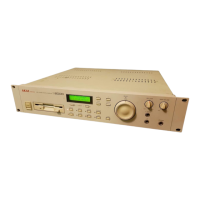PROGRAM EDIT
Page 70 S2000 Operator’s Manual - Version 1.30
ASSIGNABLE PROGRAM MODULATION
First introduced on the Akai S2800, S3000 and S3200, the S2000 has Assignable Program
Modulation (or APM for short) and this allows you to route virtually any controller (such as the
LFOs, envelope generators and MIDI controllers such as modwheel, pitchbend, etc.) to a
number of destinations (pitch, amplitude, tone, etc.). Many
synthesisers
have had such
facilities before but it is uncommon on samplers and APM turns the S2000 into a powerful
synthesiser as well as offering a great deal of flexibility in the manipulation of acoustic samples.
In the early days of synthesisers, each building block of sound was referred to as a ‘module’
and it was possible to route any module to any other using patch cords. This was called
‘modular synthesis’. On the S2000, each ‘module’ (i.e. the filters, amplifiers, pitch inputs,
LFOs, envelope generators, etc.), has several control inputs and, although we don’t use patch
cords, controllers may be freely assigned to these modules. On other samplers (and indeed
even some synthesisers), these control inputs are fixed - that is, you have no choice as what
you can send to them. Whilst acceptable a lot of the time, this can be a bit frustrating when
there is some specific sound you want to make or musical effect you want to achieve.
Here are some examples:
• You may route the mod wheel to open the filter in a brass program for swells and growls.
You could use aftertouch for the same effect.
• You could route aftertouch to control the panning’s LFO speed to emulate the sound of a
rotary speaker speeding up and slowing down in a classic rock organ sound.
• The multi-stage envelope generator ENV2 could be routed to pitch for special effects
whilst, at the same time LFO1 (whose rate may separately be being controlled by the
modwheel) is being routed to a resonant filter cutoff.
• You could use ENV2 to control LFO1 depth for ‘shaped’ vibrato that fades in, fades out
and fades back in again.
• To reduce the ‘cyclicness’ of normal vibrato, you could modulate LFO1’s rate very slightly
with LFO2.
• It is possible to ‘trigger’ the RANDOM wave from the keyboard so, if LFO2 is applied to
filter, each note can have a totally random tone. With LFO2 applied to panning, each note
will appear at a randomly different position in the L/R stereo field (great when sequencing
or arpeggiating percussive sounds)
All sorts of things are possible from the subtle to the ridiculous! We are the first to admit that
this kind of modulation is not that useful when trying to accurately recreate the sound of a
Gamelan orchestra but, when the need arises to create that special sound or when your
synthesiser just isn’t up to it, the S2000 will oblige you willingly - in fact, you may get so used to
the S2000’s versatility as a synthesiser that some of your current synth(s) may be in the
classifieds sooner than you think!

